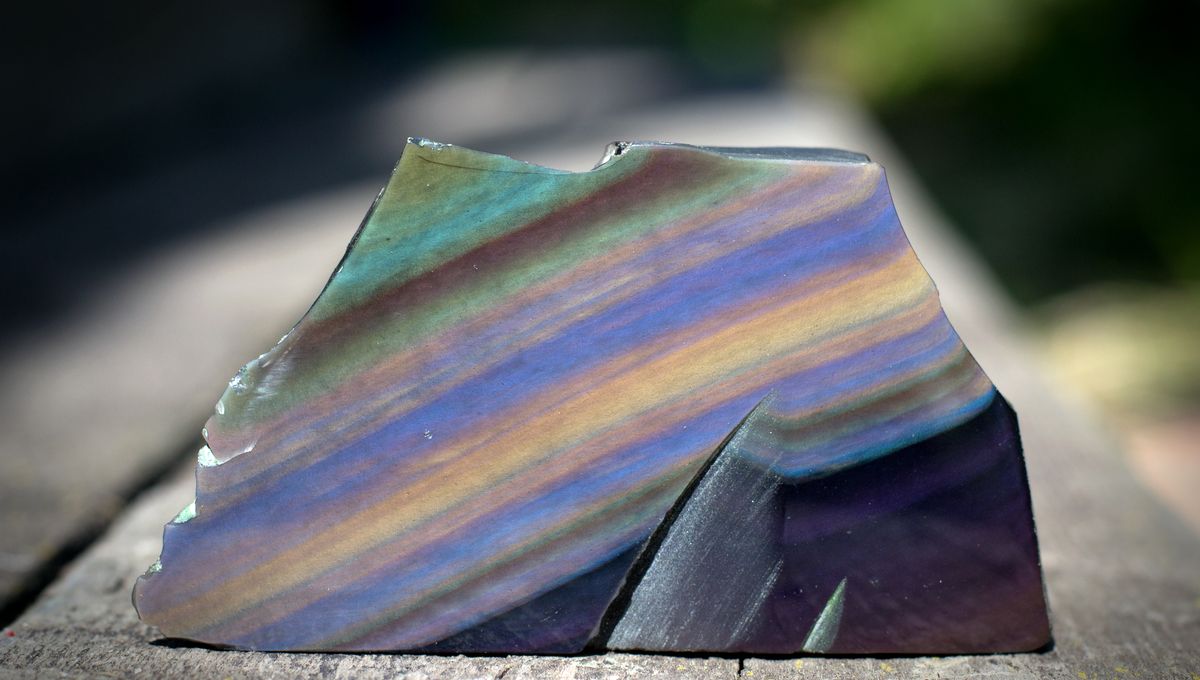
Obsidian is perhaps best known in its role as the dark black blade atop ancient spears and axes – but what if we wanted to add a little bit of pizzaz to our prehistoric weaponry? Look no further than rainbow obsidian.
What is rainbow obsidian and why is it colorful?
As we’ve just mentioned, obsidian is often thought of as being dark and opaque, but it can actually come in a whole bunch of forms with different colors and patterns. The most colorful of all may just be rainbow obsidian, which features an array of iridescent colors, including shades of green, purple, and blue.
Colorful, sure, but we’d say it reminds us more of an oil spill than a rainbow.
Its variety of colors is the result of the presence of inclusions, tiny particles of material that became trapped within the obsidian as it formed. In this case, the material is microscopic crystals of metallic magnetite, a magnetic mineral; it’s the light hitting magnetite that makes the obsidian appear colorful, rather than the mineral itself.
Is rainbow obsidian rock or glass?
As with other forms of obsidian, rainbow obsidian is both rock and glass. However, this isn’t the same kind of glass that’s used in your nice new French doors. It’s far more badass, because it started out as silica-rich magma, eventually erupting as a viscous surface lava flow. This molten earth origin is what classes rainbow obsidian as an igneous rock.
Lava destined to become obsidian cools rapidly once on the surface and, thanks to its viscous nature, is also below the point at which crystals within can grow to become sizeable – this makes rainbow obsidian a naturally occurring glass.
Where is rainbow obsidian found?
As you might’ve been able to guess given that it comes from lava, rainbow obsidian is found in places where lava has flown and cooled. One such place is the Sierra Nevada region of California, which has a long history of volcanic activity.
There are four mines in this region that, with a permit, allow the public to enter and collect obsidian, but two in particular are well known for being home to rainbow obsidian: the appropriately named Rainbow Mine and the less excitingly named Middle Fork Davis Creek Mine, both of which are found in Modoc National Forest.
Is rainbow obsidian rare?
It’s not clear exactly how rare rainbow obsidian is, but the nature of how it’s formed means that it’s limited to being found in a select few places. However, what is clear is that you’re unlikely to come across any that can be traced back more than around 20 million years ago – and the same goes for other types of obsidian too.
That’s because obsidian is pretty unstable as far as rocks go; over time, the silica molecules within it end up rearranging into a more organized fashion, a process known as devitrification. The result of this is that it gradually loses its glassy appearance, instead becoming more rock-like.
Source Link: Rainbow Obsidian: Molten Earth To A Mesmerizingly Colorful Glassy Rock